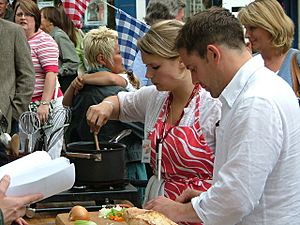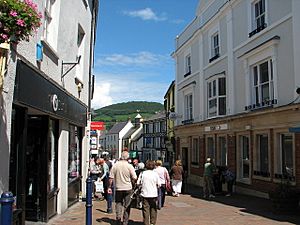Abergavenny Food Festival facts for kids
The Abergavenny Food Festival is a super fun annual event that celebrates all kinds of food! It happens every September in the town of Abergavenny in Wales. Imagine a huge party where you can explore delicious foods and learn about where they come from. It's so popular that The Independent newspaper once called it one of the 50 best summer festivals!
Contents
History of the Festival
The Abergavenny Food Festival started in 1999. Two local farmers, Chris Wardle and Martin Orbach, created it. They wanted to help local food producers after a difficult time for farmers.
A famous newspaper, The Guardian, once said that Abergavenny is like a special place for food, just like Cannes is for movies. It's a place to discover new and exciting food talents!
In 2019, over 35,000 people visited the festival. The festival did not take place in 2020. Many famous chefs and food experts have visited the festival over the years. Some of them include Antonio Carluccio, Anthony Bourdain, Hugh Fearnley-Whittingstall, and Levi Roots.
How the Festival is Organized
The Abergavenny Food Festival is a non-profit organization. This means it doesn't try to make money for owners. Instead, any money it earns goes back into making the festival even better! It's run by a group of unpaid directors and a small team of part-time staff. Many other groups and people also help support the festival.
What Happens at the Festival
The very first festival was planned in 1998 and was run by volunteers. About 39 local food and drink makers showed off their products in the Market Hall.
The first festival also had talks, like one with famous chef Marguerite Patten. There was also a big dinner called the Community Banquet, where 180 people ate together in the Market Hall. Other fun activities included farm walks and a special apple exhibition. The Abergavenny Market Hall has always been a very important place for the festival.
The money raised from tickets and stalls helps pay for future festivals.
Festival Growth and Activities
The festival has grown a lot over the years! It even won an award for "Best Event in Wales" in 2013/14. It's now one of the top food events in the whole UK.
Here are some of the cool things you can find at the festival:
- Food Stalls: There are around 220 stalls spread across different places in Abergavenny. You can find all sorts of yummy foods and drinks!
- Workshops and Talks: You can buy tickets for special classes, food tastings, and talks.
- Children's Food Academy: This is a special area at The Castle just for families. It has fun, hands-on workshops for kids of all ages!
- Speakers Corner: Famous guests come to talk about food and other interesting topics.
- Chef Demonstrations: You can watch talented chefs cook their amazing dishes live in the Market Hall and other venues.
- Party at The Castle: On Saturday evening, there's a big party at The Castle with music and food. It can hold up to 1,000 people!
Festival Debates
Since 1999, the festival has hosted debates about important food topics. These discussions help people think about where their food comes from and how it affects the world. Some topics have included:
- Whether we need genetically modified foods.
- If organic food is truly better.
- The future of our high streets and local shops.
- How to balance food production with protecting wildlife.
- If healthy eating can sometimes make us feel unwell.
Festival Conferences
From 2007 onwards, the festival also started holding conferences. These are bigger meetings where experts discuss important issues related to food. Topics have included:
- How food festivals can help local food culture.
- Developing food tourism in the UK.
- Making the food chain more sustainable (better for the planet).
- How food festivals can grow and change for the future.
- Changing attitudes towards local food.
- The impact of a recession on food.
See also






